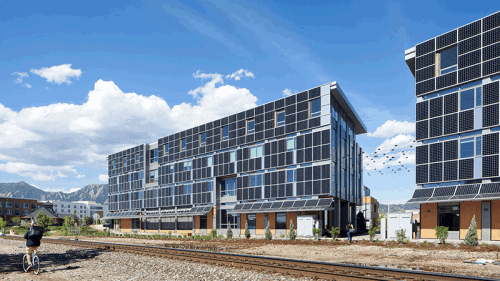Shaun Donovan, secretary of the U.S. Department of Housing and Urban Development (HUD), knows a lot about big-city housing rehabilitation and construction issues. After all, he was New York City Mayor Michael Bloomberg’s housing commissioner for four years before joining the Obama administration.
But to tap into his core passions when it comes to real estate, talk to him about the decades-long disconnects between American housing locational decisions and jobs, transportation, and smart energy policies.
He foresees—and is working to bring about—a future in which prospective homebuyers routinely receive not only energy-efficiency ratings and annual cost projections on houses they are considering, but also estimates of energy consumption for a commute to work. In combination, these disclosures should help them better understand which houses are energy guzzlers and which locations expose them to higher fuel costs to get to work and back. Such knowledge, he believes, could significantly affect consumers’ decision making about where they want to be and how big a house they need and can afford—perhaps leading them to the conclusion that smaller, denser, and closer in are better. Ultimately, builders and local governments should get the same message.
“Real economic and environmental sustainability isn’t just about the kind of buildings we build, but about where we build them,” he says.
As a cabinet member, Donovan is a surprisingly blunt critic of the federal government itself, which he says “created many of the incentives for the disconnect between where people live and where they work, where they go to school, where they shop.” Among the harmful government policies are trillion-dollar highway investments, insufficient investments to encourage public transit such as light rail, excessive restrictions and regulations that discouraged infill housing development, plus heavy tax incentives that continue to favor single-family subdivisions over affordable multifamily projects.
In an interview with Urban Land online magazine earlier this month, Donovan took that critique one step further. He directly linked poor locational decisions on housing, jobs, and transportation with some of the most costly collateral damage of the great housing boom and bust: new residential subdivisions built far from employment centers and convenient transit—such as California’s Central Valley and Prince William County, Virginia, among others—that have suffered far steeper declines in property values and higher rates of foreclosure than neighborhoods closer to the urban center and more convenient to mass transit.
While that may seem clear in the rearview mirror, the question is what HUD—or Donovan himself—can do now about overcoming these past shortcomings in planning. His answer: leverage billions of dollars of grants and formula funding on the condition that it is spent in accordance with rational, sustainable principles. He would like to insist that sustainability and smart growth principles are integrated into virtually every grant and policy made not only by HUD, but by other federal agencies that affect the built environment, such as the Department of Transportation (DOT), the Department of Energy, and the Environmental Protection Agency (EPA).
That process already is well underway at HUD. It has begun applying Leadership in Energy and Environmental Design (LEED) and LEED for Neighborhood Development as key criteria for its entire portfolio of competitive grants. It also is heading toward incorporating sustainability requirements into its multibillion-dollar Community Development Block Grant program, which is likely to affect local projects across the country once fully implemented.
Donovan says the message to private developers, planning agencies, and local governments is straightforward. “If you want competitive money—just as with the [administration’s] Race to the Top program in education—we’ve set sustainability as a criterion for all of our funds,” he says. “And that’s really going to begin to change the game on a broad scale.”
Beyond that, Donovan has created the Office of Sustainable Housing and Communities, bringing HUD, DOT, and the EPA together in an effort to ensure that funding decisions by all three agencies weigh housing affordability, transportation, and environmental protection in every funding disbursement they make that has any connection with real estate development. Last October, the three agencies’ Partnership for Sustainable Communities joint venture awarded its first $100 million in planning grants to 45 local community development and planning groups. That same month, HUD and DOT awarded $68 million in grants to 62 local and regional partnerships working on transit-oriented real estate projects designed to connect affordable housing and employment in innovative ways.
Donovan does not expect any of this to change local planning practices and private investment overnight. But there is a significant amount of federal money involved, and sustainability criteria for future funding make sense.
Other top priorities for Donovan that emerged in the interview are the following:
* Fannie-Freddie reform. The administration’s white paper on Fannie Mae-Freddie Mac reform primarily “will lay out options” for Congress, according to Donovan, “but we won’t say there’s a single path that makes sense.” The report also will recommend changes to FHA’s mortgage insurance programs as part of a transition strategy to a smaller federal footprint in the housing market, but he refused to spell out the specifics.
* Green refinancing for multifamily. HUD will announce soon details of a “green refi” program designed to fund expensive energy retrofits and upgrades for aging apartment projects.
* PowerSaver mortgages. About 30 lenders already have signed up to provide Federal Housing Administration–insured loans of up to $25,000 on favorable terms to homeowners who want to make energy efficiency improvements to their real estate, ranging from new HVAC systems, solar panels, geothermal installations, and new doors, windows, and water heaters. In a twist that may signal a new direction for FHA, the agency will insure no more than 90 percent of the loan amount, leaving lenders to take the 10 percent balance of the default risk—representing their own “skin in the game.”
* Energy labeling for existing homes. HUD has nine pilot programs either underway or set for launch soon around the country to develop large-scale methods of rating and auditing the energy efficiency of homes before sale—a sort of real estate equivalent of the ubiquitous fuel mileage labels on new cars. Once the pilot programs are completed, Donovan hopes to roll out the concept nationwide. Participation by sellers will be voluntary, Donovan emphasized. PowerSaver mortgage money will be available to finance energy upgrades for buyers or owners who seek them.
* Brownfields. HUD has liberalized its remediation requirements to facilitate greater use of FHA financing for new apartment projects on former brownfield sites, while still “safeguarding the health of future residents,” Donovan says.



